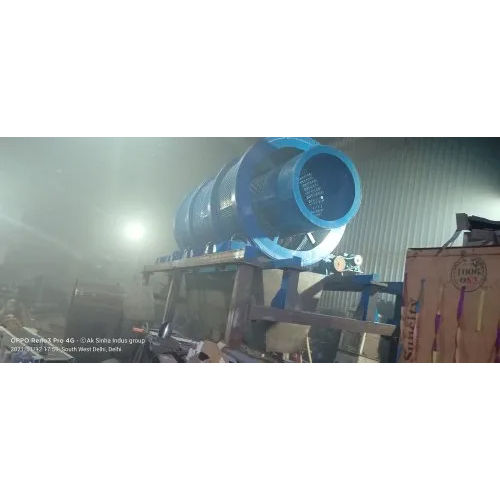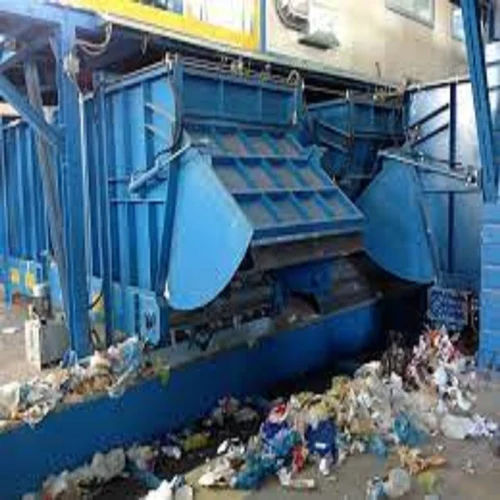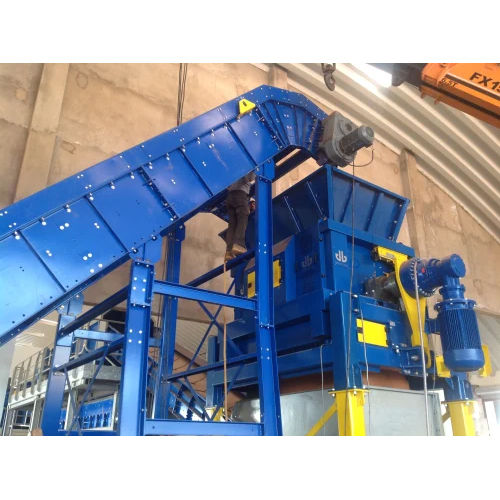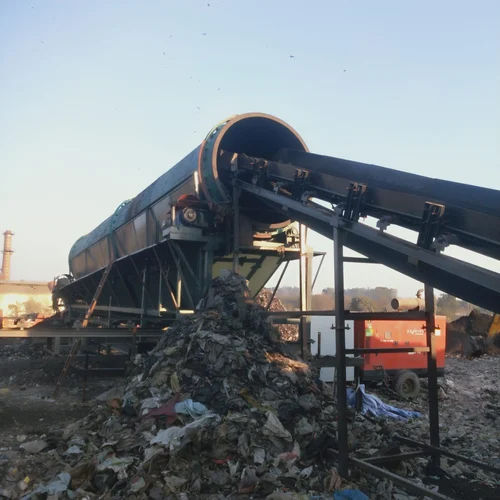Specification
- टाइप करें
- मटेरियल
- ऑपरेटिंग टाइप
- उपयोग का स्तर
- पोर्टेबल
- पावर सोर्स
- Electronic
- रंग
- Blue
Trade Information
- Minimum Order Quantity
- 1 Unit
- एफओबी पोर्ट
- Indian
- आपूर्ति की क्षमता
- प्रति महीने
- डिलीवरी का समय
- दिन
- नमूना उपलब्ध
- No
- नमूना नीति
- मुख्य निर्यात बाजार
- मुख्य घरेलू बाज़ार
About
A trommel screen, also known as a rotary screen, is a crucial component in a solid waste recycling plant, particularly for the mechanical separation of different sizes of materials. It's essentially a large, rotating cylindrical drum with numerous perforations or openings of specific sizes along its surface.
Here's a detailed description:
Function:
The primary function of a trommel screen is to classify or sort mixed solid waste materials by size. As waste enters one end of the rotating drum, smaller particles (like dirt, sand, and small organics) fall through the smaller openings, while larger materials (like plastics, metals, wood, and larger organic waste) tumble along the length of the drum until they exit through larger openings or the end of the trommel.
Construction and Design:
- Cylindrical Drum: The core of the trommel screen is a large, typically slightly inclined, cylindrical drum. The inclination helps in the gravitational flow of material through the screen.
- Perforated Plates/Mesh: The drum's surface is fitted with perforated plates or mesh panels. These panels have precisely sized holes that determine the cut-off size for separation. Different sections of the trommel can have varying hole sizes, starting with smaller openings at the inlet and progressively larger ones towards the outlet to achieve multi-stage separation.
- Support Frame: The drum is supported by a robust steel frame that houses the drive mechanism and bearings.
- Drive Mechanism: A motor and gearbox system rotate the drum at a controlled speed. The rotational speed is critical for efficient screening too slow, and material won't separate effectively; too fast, and material might be carried over rather than screened.
- Internal Lifters/Agitators (Optional): Some trommels may have internal lifters or paddles. These help to agitate the material, break up clumps, and ensure better exposure to the screen openings, leading to more efficient separation.
- Feeding and Discharge Systems: The trommel is integrated with conveyors or chutes for feeding the mixed waste into the inlet and separate conveyors or hoppers for collecting the screened fractions at the discharge end.
- Cleaning System (Optional): To prevent clogging, especially with sticky or wet materials, some trommels incorporate a cleaning system, such as brushes or high-pressure spray nozzles.
Working Principle:
- Feeding: Mixed solid waste is fed into the elevated end of the rotating trommel drum.
- Tumbling and Agitation: As the drum rotates, the material tumbles and agitates. This action helps to break apart compacted waste and expose different particles to the screen openings.
- Size Separation:
- Undersize Material: Particles smaller than the screen openings fall through the perforations into collection hoppers or onto conveyors beneath the trommel.
- Oversize Material: Larger particles that cannot pass through the openings continue to tumble along the length of the drum, gradually moving towards the lower discharge end.
- Multi-Stage Screening (Common): Many trommel screens are designed with multiple sections, each with different aperture sizes. This allows for several fractions to be separated in a single pass (e.g., separating fines first, then medium-sized materials, and finally the largest fraction).
Advantages in Solid Waste Recycling:
- Effective Size Separation: Highly efficient in separating materials based on size, which is a fundamental step in most recycling processes.
- High Throughput: Can process large volumes of waste continuously.
- Versatility: Can handle a wide variety of waste streams, from municipal solid waste (MSW) to construction and demolition (C&D) waste.
- Reduces Downstream Processing: By removing fines and unwanted large items early in the process, it protects and improves the efficiency of subsequent machinery (e.g., shredders, optical sorters).
- Improved Product Quality: Leads to cleaner, more homogeneous material streams, enhancing the value of recycled products.
- Low Maintenance (Relatively): Generally robust and requires relatively low maintenance compared to some other separation technologies.
Applications in a Solid Waste Recycling Plant:
- Pre-sorting: Often the first mechanical separation step after initial manual sorting or pre-shredding.
- Composting: Separating fine organic material from larger inert materials.
- Material Recovery Facilities (MRFs): Sorting mixed recyclables like paper, plastics, and glass.
- Construction and Demolition (C&D) Waste: Separating soil, concrete, wood, and metals.
- Refuse Derived Fuel (RDF) Production: Sizing materials for further processing into fuel.
In essence, the trommel screen is a workhorse in solid waste recycling, providing a fundamental and highly effective method for preliminary material classification, which is vital for the overall efficiency and success of the recycling process.


Price: Â
- 50
- 100
- 200
- 250
- 500
- 1000+







